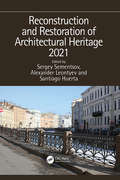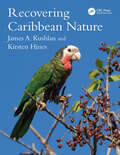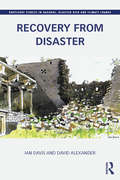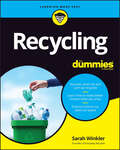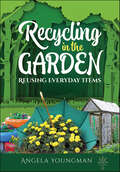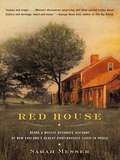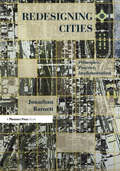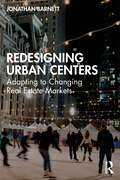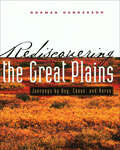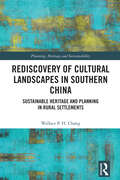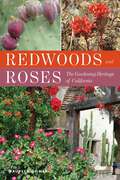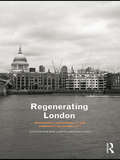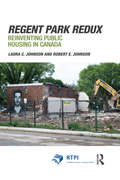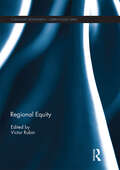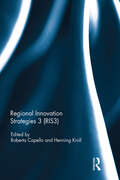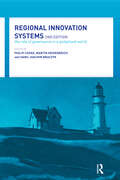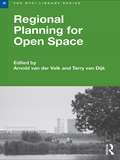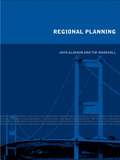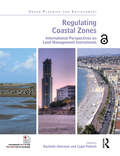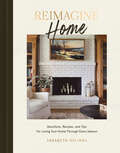- Table View
- List View
Reconstruction and Restoration of Architectural Heritage 2021: Proceedings of 3rd International Conference on Reconstruction and Renovation of Architectural Heritage, March 24-27, 2021, Saint Petersburg, Russia
by Sergey SementsovReconstruction and Restoration of Architectural Heritage 2021 presents contributions on various aspects of the study, protection and restoration of architectural monuments and on the reconstruction of major historical urban development sites. Moreover, various complex and problematic aspects of engineering reconstruction of monuments are discussed. A wide range of issues is considered in the process of preserving historical heritage, including: the historical formation of buildings, construction and territories; the conservation, reconstruction and restoration of buildings and constructions; the transformation of historical spaces and areas. parallels and features in the development of urban planning, architecture and construction art in Russia and Spain the fate and work of Augustine Augustinovich Betancourt This collection of papers combines contributions about the history and restoration of many of the largest nature reserves, estates, cities and monuments. It is intended for academics and professionals involved in the history and restoration of nature reserves, estates, cities and monuments.
Record Tools: Reprint of Catalogue No.15 of 1938. With a Guide for Plane Collectors
by Leslie Harrison Roy ArnoldThis is a reprint of the complete 1938 Catalogue No 15 of Record Tools together with an introduction detailing the complete history of the company and its products from its founding by the Hampton Brothers in 1898 through the acquisition of the Preston List in the early 1930s to the present day Record Tools. The introduction by Leslie Harrison concentrates on the planes Record produced from 1931 onwards and includes the acquisition of planes formerly made by Edward Preston; and it contains details of all planes advertised and produced since 1938. This No 15 Catalogue was the most comprehensive and representative of the Record line of tools ever produced. The lists and catalogues since then have been largely updates. This volume is printed on high-quality gloss paper and includes illustrations of the tools and parts throughout the text. Appropriate patent documents are included. The catalogue is divided into six sections: Planes and Spoke Shaves; Hand & Breast Drills; Vices for Metal and Wood; Pipe Vices, Wrenches, & Cutters; Bolt Clippers, and Cramps. Leslie Harrison has been collecting and researching Record planes for years. He has a definitive collection of them and is acknowledged as an authority. He has had full cooperation in this study from Record Tools and the Hawley Collection Trust at Sheffield University. Hundreds of B&W images
Recovering Caribbean Nature
by James A. Kushlan Kirsten HinesThe Caribbean is a global biodiversity hotspot; half its resident bird species are found nowhere else, yet, a quarter are threatened with extinction. Nearly all its native amphibians and reptiles and thousands of plants also are endemic. Yet, less than 1% of the landscape can be considered natural; and apart from reserves, most land is privately owned. Despite the challenges of such habitat fragmentation, the Caribbean’s distinctive fauna and flora can be preserved through planning and managing a connected network of sustainable naturalistic landscapes, reserves, parks, and private gardens. This book uniquely provides both a theoretical background and practical applications to restoring nature within the tropical Caribbean. Packed with beautiful color photographs, it offers unifying principles that can be applied across the tropics and synthesizes information on the Caribbean's environmental uniqueness and globally significant biodiversity. It also provides explicit guidance on establishing sustainable and more naturalistic landscapes from large public lands to private yards and gardens.The book is essential reading for academics and researchers studying the Caribbean environment, resource management professionals, and scientists and.educatos from nongovernmental organizations who provide programs and advocacy for conservation and regional sustainability. Moreover, it highlights the importance of private lands and gardens, where the greatest gains can be made, and so offers a handbook for knowledgeable private landowners and their professional advisors.
Recovery from Disaster (Routledge Studies in Hazards, Disaster Risk and Climate Change)
by David Alexander Ian DavisDisasters can dominate newspaper headlines and fill our TV screens with relief appeals, but the complex long-term challenge of recovery—providing shelter, rebuilding safe dwellings, restoring livelihoods and shattered lives—generally fails to attract the attention of the public and most agencies. On average 650 disasters occur each year. They affect more than 200 million people and cause $166 trillion of damage. Climate change, population growth and urbanisation are likely to intensify further the impact of natural disasters and add to reconstruction needs. Recovery from Disaster explores the field and provides a concise, comprehensive source of knowledge for academics, planners, architects, engineers, construction managers, relief and development officials and reconstruction planners involved with all sectors of recovery, including shelter and rebuilding. With almost 80 years of first-hand experience of disaster recovery between them, Ian Davis (an architect) and David Alexander (a geographer) draw substantially from first-hand experiences in a variety of recovery situations in China, Haiti, Italy, Japan, New Zealand, Pakistan, the Philippines and the USA. The volume is further enriched by two important and unique features: 21 models of disaster recovery are presented, seven of which were specifically developed for the book. The second feature is a survey of expert opinion about the nature of effective disaster recovery—the first of its kind. More than 50 responses are provided in full, along with an analysis that integrates them with the theories that underpin them. By providing a framework and models for future study and applications, Davis and Alexander seek both to advance the field and to provide a much-needed reference work for decision makers. With a broad perspective derived from the authors' roles held as university professors, researchers, trainers, consultants, NGO directors and advisors to governments and UN agencies, this comprehensive guide will be invaluable for practitioners and students of disaster management.
Recycling For Dummies
by Sarah WinklerLearn the facts about recycling and discover the best way to make an impact Recycling is a simple action we can take that has an immediate positive effect. It keeps waste out of landfills, conserves natural resources, prevents pollution, and saves energy. Who wouldn’t want to do this? But recycling isn’t always straightforward. With so many different rules, it can be tough to work out the right thing to do. If you’re worried that you’re not recycling properly, or wondering whether you could be recycling more, this is the book for you. Recycling For Dummies cuts through the confusion around what you can and can’t recycle. This easy-to-follow manual breaks down recycling codes, symbols, and rules in a straightforward way that anyone can understand and apply. You’ll gain insight into the recycling process (where does that stuff go, anyway?) and learn tons of tips on reusing items in your daily life to cut down on waste. It also guides you on how to make smarter choices as a consumer to help preserve the planet for generations to come. Figure out what common materials can and can’t be recycled Understand what the recycling symbols are telling you Explore the many specialist recycling services available Learn what happens to your recyclables after they get picked up Become a true recycler by switching to recycled productsCheck out this book if you want to make your efforts count and be part of the recycling solution.
Recycling in the Garden: Reusing Everyday Items
by Angela YoungmanPeople are becoming more aware of the environment and their impact on it. Over the past decades we have become an increasingly consumerist based society. From a world in which recycling was common, single use became the norm. This throwaway society is unsustainable. Sustainable gardening results in the creation of an environmentally friendly area in which natural predators thrive and soils are naturally replenished. Discover innovative and simple ways of recycling everything from water to materials in the garden. Practical examples show recycling in action turning unwanted items into useful features such as bottle edging, footpaths made from tyres, garden forks into table lamps, broken pottery to mosaics and tree roots into lush garden stumperies. Recycling, reusing and upcycling in the garden can make a difference helping you save money by using less water, making your own compost, choosing energy efficient equipment and by giving everyday items a totally new function. Instead of a throwaway society, we are increasingly looking at ways of reducing our use of increasingly scarce resources, turning plastic into paths, using solar energy and conserving water. Natural recycling of plant material and sustainable gardening is increasingly popular. This book helps search for creative ideas that can conserve resources, and save you money. Water is no longer cheap, so the book suggests many ways that you can re-use water and get free rainwater. The book helps you with places you may not think of looking for free and cheap material, such as reclamation yards, factories, restaurants and hospitals. Let your imagination run free without needing much skill and without breaking the bank.
Red House
by Sarah MesserIn her critically acclaimed, ingenious memoir, Sarah Messer explores America’s fascination with history, family, and Great Houses. Her Massachusetts childhood home had sheltered the Hatch family for 325 years when her parents bought it in 1965. The will of the house’s original owner, Walter Hatch—which stipulated Red House was to be passed down, "never to be sold or mortgaged from my children and grandchildren forever"—still hung in the living room. In Red House, Messer explores the strange and enriching consequences of growing up with another family’s birthright. Answering the riddle of when shelter becomes first a home and then an identity, Messer has created a classic exploration of heritage, community, and the role architecture plays in our national identity. .
Redesigning Cities: Principles, Practice, Implementation
by Jonathan BarnettThis book is recommended reading for planners preparing to take the AICP exam. Too often, no one is happy with new development: Public officials must choose among unappealing alternatives, developers are frustrated and the public is angry. But growing political support for urban design, developers' interest in community building and successful examples of redesigned cities all over the U.S. are hopeful signs of change. The author explains how design can reshape suburban growth patterns, revitalize older cities, and retrofit metropolitan areas where earlier development decisions went wrong. The author describes in detail specific techniques, materials, and technologies that should be known (but often aren't) to planners, public officials, concerned citizens, and others involved in development.
Redesigning Urban Centers: Adapting to Changing Real Estate Markets
by Jonathan BarnettRedesigning Urban Centers: Adapting to Changing Real Estate Markets describes how well-managed places which offer clean, safe, and attractively designed streets and public spaces, along with reinvented zoning, are drawing real estate investors and developers to reimagined legacy downtowns, innovation districts, edge cities becoming real cities, suburban shopping streets turning into mixed-use centers, urban districts near airports, and bypassed downtowns relying on government support. Case studies from the Philadelphia metropolitan region, plus examples from across the U.S., demonstrate how designs which integrate offices, housing, shopping, hotels, and entertainment, along with cultural and other attractions, transform places where people have to be into places where people want to be.This book will interest leaders of business improvement districts and Main Street organizations, planning officials, urban design practitioners, and instructors and students of planning, economic development, and urban design.
Rediscovering the Great Plains: Journeys by Dog, Canoe, and Horse (Creating the North American Landscape)
by Norman Scott HendersonEngaging travel memoir recounts author's adventures traveling in Canada's Qu'Appelle River Valley via horse, canoe, and Native American dogsled.The North American Plains are one of the world's great landscapes—perhaps the signature landscape of the continent. Today, the most intimate experience most of us have of the great grasslands is from behind the window of a car or train. It was not always so. In the earliest days, Plains Indians traveled on foot across the vastness, with only the fierce, wolflike Plains dogs as companions. Later, with the arrival of the Europeans, horses and canoes appeared on the Plains. In Rediscovering the Great Plains, Norman Henderson, a leading scholar of the world's great temperate grasslands, revives these traditional modes of travel, journeying along 200 miles of Canada's Qu'Appelle River valley by dog and travois (the wooden rack pulled by dogs and horses used by Native Americans to transport goods), then by canoe, and finally by horse and travois.Henderson interweaves his own adventures with the exploits of earlier Plains travelers, like Lewis and Clark, Francisco Coronado, La Vérendrye, and Alexander Henry. Lesser-known experiences of the fur traders and others who struggled to cross this strange and forbidding landscape also illuminate the story, while Henderson's often humorous description of his attempts to find and train old Plains breeds of dogs and horses highlight the difficulties involved in recreating archaic travel methods. He also draws on the history of the world's other great temperate grasslands: the South American pampas and the Eurasian steppes. Recalling the work of Ian Frazier and Jonathan Raban, Henderson's captivating account of his three journeys of exploration will foster a better appreciation for, and deeper understanding of, the natural and human history of the North American Plains.
Rediscovery of Cultural Landscapes in Southern China: Sustainable Heritage and Planning in Rural Settlements (Planning, Heritage and Sustainability)
by Wallace P.H. ChangThis book investigates the concept of human landscape in rural settlements in Southern China, where communities and their cultural landscapes are facing contemporary challenges following a period of rapid urbanization in the last 50 years. While metropolitan cities, such as Hong Kong, are experiencing accelerated urban development, underpopulated rural villages are struggling to maintain the cultural heritage of their regions. Rediscovery of Cultural Landscapes in Southern China provides a detailed account into indigenous living cultures in traditional, rural settlements upon natural landscapes. Beginning with an overview of the theoretical framework, the book presents six unique cases, including: Tai O, Yim Tin Tsai, Lai Chi Wo, Nga Tsin Wai, Cangdong, and Meinong, while illustrating a relevant comparison between Hakka and Satoyama landscape systems. The spectrum of theoretical and case analyses allows for a rethinking of the evolving cultural landscape’s positioning with valuable heritages in the context of a post-industrial society. The book is written towards reinterpreting the cultural landscape by conceptualizing the human landscape for scholars, practitioners, and students interested in rural-cultural conservation and revitalization, heritage management, traditional architecture and landscape planning, and urban-rural development.
Redwoods and Roses: The Gardening Heritage of California
by Maureen GilmerRedwoods and Roses explores the special relationship California&’s diverse peoples have shared with nature and the unique gardens and landscapes they have created over the years to nurture and enhance those bonds. From pre-colonial times to the Victorian era, California gardening expert Maureen Gilmer brings this garden history to life, showing how the gardens and landscapes were created and profiling the heirloom plants within them. But Redwoods and Roses is more than a book on gardening history. Here, the reader will discover how to recreate period designs in her own garden, from making a no-fuss adobe-look wall from the Mission era to finding heirloom plants for a cottage garden. Redwoods and Roses is a blend of natural history, California history, plants profiles, landscaping tips, and sensible garden advice, as well as an eloquent plea for the preservation of many remarkable plants.
Reformas domésticas
by Francesco Poggi* Renovar uno mismo su propia casa no es una tarea imposible, si se siguen con atención las indicaciones de este libro. * Pintar las paredes, empapelar, efectuar revestimientos con madera, tapizar con moqueta, colocar el parqué, embaldosar y mil tareas más no tendrán secretos con las detalladas explicaciones y las ilustraciones didácticas que llenan las páginas de esta obra. * Así, podrá decir por fin adiós a las facturas astronómicas de los pintores y tapiceros, y tendrá la satisfacción de un trabajo realizado con esmero.
Regenerating Essential Goods and Services in Urban Landscapes: Sustainability Through Ecological Design
by Douglas KentHow do we provide for and nurture millions of people without destroying the planet in the process? Author Doug Kent, an environmental specialist, believes a vital element in the solution is recognizing that urban landscapes are an essential partner in everyone’s wellbeing. He argues that urban landscapes can and must work harder.Urban landscapes can provide part of our energy needs, help cool our buildings and public spaces, help us make the most of our precious water. They can also help combat air pollution and reduce the likelihood of allergies and asthma. They can provide landscape materials and even contribute to our timber supply. Doug also advocates turning landscapes into a food source, and/or a perfumery, pharmacy, soap shop, or craft store.Doug has over 12 years of research in this book. He has spent years doing literature reviews, and many more years concocting, consuming, crafting, distilling, propagating, retting, sawing, sowing, and weaving its many recommendations. He has also travelled the length and width of California many times to interview the people and businesses already doing this incredible work.Regenerating Essential Goods and Services is not a manifesto. It is a user’s manual. You are the creative and energetic force that will ultimately drive sustainability and regeneration. Let’s go.
Regenerating London: Governance, Sustainability and Community in a Global City
by Rob Imrie Loretta Lees Mike RacoRegenerating London explores latest thinking on urban regeneration in one of the fastest changing world cities. Engaging with social, economic, and political structures of cities, it highlights paradoxes and contradictions in urban policy and offers an evaluation of the contemporary forms of urban redevelopment.
Regeneration, Heritage and Sustainable Communities in Turkey: Challenges, Complexities and Potentials
by Muge Akkar ErcanOver the last three decades, historic housing areas have become one of the major concerns in urban regeneration, housing renovation and conservation projects. Since the late 1990s, the notion of community, sustainability and sustainable community have become rising issues in the urban regeneration debate. Regeneration, Heritage and Sustainable Communities in Turkey contributes to this debate by integrating the interplay between regeneration, community needs and sustainability in the context of Istanbul. Together with the relational, multi-scalar and contingency planning approaches, these vital agents of regeneration provide new possibilities and creative opportunities to successfully deal with the uncertainties and complexities in evolving regeneration spaces. The interdisciplinary text reasons that finding the balance between the needs, aspirations and concerns of local communities and the conservation of the built environments will lead to more equitable and sustainable solutions to the problems faced in Istanbul’s historic quarters.
Regent Park Redux: Reinventing Public Housing in Canada (RTPI Library Series)
by Laura Johnson Robert JohnsonRegent Park Redux evaluates one of the biggest experiments in public housing redevelopment from the tenant perspective. Built in the 1940s, Toronto’s Regent Park has experienced common large-scale public housing problems. Instead of simply tearing down old buildings and scattering inhabitants, the city’s housing authority came up with a plan for radical transformation. In partnership with a private developer, the Toronto Community Housing Corporation organized a twenty-year, billion-dollar makeover. The reconstituted neighbourhood, one of the most diverse in the world, will offer a new mix of amenities and social services intended to "reknit the urban fabric." Regent Park Redux, based on a ten-year study of 52 households as they moved through stages of displacement and resettlement, examines the dreams and hopes residents have for their community and their future. Urban planners and designers across the world, in cities facing some of the same challenges as Toronto, will want to pay attention to this story.
Regional Equity (Community Development – Current Issues Series)
by Victor RubinRegional equity as a field of scholarship, as an arena of policy change, and as a social movement has grown, diversified, and matured in important ways over the past decade. The fruits of that growth and development can be seen in recent federal and state policies, in the practices of many regional planning organizations, and in the agendas and approaches of countless community-based organizations and issue advocacy groups.As the field has expanded, a growing number of researchers have been tracking these phenomena: explaining how and why concepts of metropolitan development are being reframed; documenting the efforts to shape policies and diversify leadership; assessing where and how equity and social justice concerns have been brought into regional planning for transportation, land use, housing, public finances, environmental quality, smart growth, sustainable development, public health and other issue areas. This volume brings together analyses and commentary by some of the leading scholarly observers these timely developments.This book was published as a special issue of Community Development.
Regional Innovation Strategies 3 (RIS3)
by Roberta Capello Henning KrollWith regions and nations having formally fulfilled the ex ante conditionality, this book provides a first overall review of RIS3 policy processes, aiming to assess the consistency of the concept of smart specialization from an applied, policy-oriented perspective. Moving from the theory of design to the practice of implementation, the reflections and case studies in this volume reveal strengths and weaknesses in the way concrete strategies have been conceived and implemented, enabling reflections on the future of the concept in a more general sense. In many cases, smart specialization strategies turn out to be new variants of regional development policies, embracing the importance of a place-based approach. However, the approach’s potential to add distinctive value will stem from its capacity to turn innovation and knowledge into tools for local development by harnessing them for wider territorial development goals. By helping regions to identify and leverage untapped resources through new processes, smart specialization-based policies may help to reconcile cohesion and competitiveness objective. Consequently, new approaches appear most promising where institutional, administrative and political conditions allow the setup of genuinely new processes and where their focus is on territorial assets in a comprehensive manner rather than mere industrial renewal. This book was originally published as a special issue of European Planning Studies.
Regional Innovation Systems: The Role of Governances in a Globalized World
by Philip Cooke Martin Heidenreich Hans-Joachim BraczykSince the first edition of this book in 1995, there has been a worldwide innovation-led economic boom and a subsequent slump, meaning enormous change has also occurred at the level of regional economies. The new edition registers this change and provides an interesting test of the robustness of the original arguments in the book. Not least, more industrial policy making is influenced by the RIS analysis, and many national and regional governments have adopted RIS approaches, along with related instruments like promotion of industry clusters, academic entrepreneurship, regional venture capital and science-led development strategies.
Regional Planning for Open Space (RTPI Library Series)
by Arnold Van Der Valk Terry Van DijkReviewing the limitations of various planning options, this book addresses the debate on how to preserve open space in the context of a growing metropolis. The importance of open spaces for well-being in urban life is well-established. With case studies on internalization and valuation methods, this book critically examines the liberal discourse that urges the transfer of responsibility for open space from government to the market. European and American expert authors confront political rhetoric with grounded analysis and conclude that the market needs to be combined with governmental efforts. They scrutinize the connection between open space and the planning institutions designed to implement its policy. The book provides practical pieces of insight in how to structure an open space problem, information on what to expect from instruments, and new ideas on alternative approaches.
Regional Planning: Concepts, Theory And Practice (Natural and Built Environment Series)
by Tim Marshall John GlassonRegional Planning provides a comprehensive introduction to the concepts and theory of regional planning in the UK. Drawing on examples from throughout the UK, it provides students and practitioners with a descriptive and analytical foundation for understanding this rapidly changing area of planning. The book includes four main sections covering: the context and history of regional planning theoretical approaches evolving practice future prospects. New questions and methods of theorizing are explored and new connections made with contemporary debates in geography, political science and planning theory. The elements of critical analysis allow both practitioners and more advanced students to reflect upon their activities in a contemporary context. Regional Planning is the essential, up-to-date text for students interested in all aspects of this increasingly influential subject.
Regions and Designed Landscapes in Georgian England (Routledge Research in Landscape and Environmental Design)
by Sarah SpoonerGarden design evolved hugely during the Georgian period – as symbols of wealth and stature, the landed aristocracy had been using gardens for decades. Yet during the eighteenth century, society began to homogenise, and the urban elite also started demanding landscapes that would reflect their positions. The gardens of the aristocracy and the gentry were different in appearance, use and meaning, despite broad similarities in form. Underlying this was the importance of place, of the landscape itself and its raw material. Contemporaries often referred to the need to consult the ‘genius of the place’ when creating a new designed landscape, as the place where the garden was located was critical in determining its appearance. Genius loci - soil type, topography, water supply - all influenced landscape design in this period. The approach taken in this book blends landscape and garden history to make new insights into landscape and design in the eighteenth century. Spooner’s own research presents little-known sites alongside those which are more well known, and explores the complexity of the story of landscape design in the Georgian period which is usually oversimplified and reduced to the story of a few ‘great men’.
Regulating Coastal Zones: International Perspectives on Land Management Instruments (Urban Planning and Environment)
by Rachelle Alterman Cygal PellachRegulating Coastal Zones addresses the knowledge gap concerning the legal and regulatory challenges of managing land in coastal zones across a broad range of political and socio-economic contexts. In recent years, coastal zone management has gained increasing attention from environmentalists, land use planners, and decision-makers across a broad spectrum of fields. Development pressures along coasts such as high-end tourism projects, luxury housing, ports, energy generation, military outposts, heavy industry, and large-scale enterprise compete with landscape preservation and threaten local history and culture. Leading experts present fifteen case studies among advanced-economy countries, selected to represent three groups of legal contexts: signatories to the 2008 Mediterranean ICZM Protocol, parties to the 2002 EU Recommendation on Integrated Coastal Zone Management, and the USA and Australia. This book is the first to address the legal-regulatory aspects of coastal land management from a systematic cross-national comparative perspective. By including both successful and less-effective strategies, it aims to inform professionals, graduate students, policy makers, and NGOs of the legal and socio-political challenges as well as the better practices from which others could learn.
Reimagine Home: Devotions, Recipes, and Tips for Loving Your Home Through Every Season
by Sarabeth GalimbaSimplify your home and experience the peace God wants for you in every season with twenty-eight encouraging devotions, practical decorating tips, and stunning photography.Home—whether a camper van, mansion, or anything in between—is where we recharge and rest, where we learn and grow, and where we welcome others. And for Christians, our home should be a small reflection of God's kingdom on earth. Unfortunately, our homes often feel anything but peaceful, ordered, or representative of who we are. If this sounds familiar, consider Reimagine Home a gift of inspiration and your personal invitation to quiet all voices of comparison and tune in to what really matters when it comes to your home—creating a space where you can know the love of God and share that love with others. With twenty-eight devotions that span the four seasons of the year, Reimagine Home encourages you to begin creating the home you want on a schedule that works for you, offering customizable tactics, helpful tips, and an undated format. Accompanied by beautifully inspiring, full-color photographs that inspire peace instead of perfection, this devotional provides a sense of calm to each day.As you read each short reflection and explore the practical home styling tips, you will be inspired to curate a home that reflects who you are and welcomes others the moment they walk in the door.
